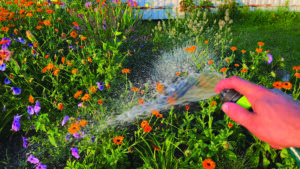
Slow watering is always best, and only water between 5 a.m. and 10 a.m. This prevents evaporation and scorching your grass or plants, and it is the most efficient use of water.
This month I want to discuss the proper watering of plants.
I have had many questions from customers on the proper way to water lawns and landscape gardens.
While it may appear to be a simple task, the fact is there are a lot of factors to consider.
August traditionally is one of the drier months of the year, and usually it is when we have a drought, along with unrelenting heat and humidity. Well, as we have all experienced so far this summer, it has been hazy, hot and humid, with a large amount of precipitation.
Here are some of my thoughts on watering.
Soil types play a factor as sandier soils like those in northern Dorchester County and almost all of Caroline County, have a need for water more often — usually every three days with no rain. You can help sandier soils by applying Leafgro or another type of compost with a high humus rating, which will help hold more moisture in the soil. Clay soils tend to hold moisture longer and usually need irrigation when no rain has been present for a five too seven-day period.
Remember every garden and yard has its own unique microclimate, where sunlight, shade and air flow can affect each garden differently.
Understanding how heat, humidity and air flow effects, your garden helps determine how to water correctly. The hotter and drier the air could mean your plants may need more water.
The windier the exposure, the sooner container plants and garden soils can dry out.
Remember don’t water by routine, but only water when the soil feels dry beneath the mulch. Overwatering is always bad for plants.
The wetter the season and the higher the humidity, the more likely the soil can become waterlogged.
When planning your garden make sure you provide good drainage, and make provisions for all down spouts to be diverted away from your plants.
In the case where the soil may take longer to dry out, consider putting a French drain under the plant. Simply dig the hole for planting as normal, then take a post hole digger and dig two or three holes at the bottom going down at least two feet. Then fill the holes with gravel, which will allow for the extra water to travel below the root zone of the plant which can cause phytophthora (root-rot), which can kill your plant.
Lawns need an inch and a half of water every week to keep them healthy and looking good. Water anytime your lawn retains footprints or the grass blades curl inward and the blades begin to turn a blue-grey color. When you water, use a sprinkler that delivers the water slowly. This avoids wasteful runoff and the moisture will go deep, and the roots of the grass will then grow down away from the heat and drought at the surface.
Electrically timed irrigation systems tend to ignore the weather
(Unless they have a rain gauge or sensor as part of the system). They are often not set properly and water too often and too shallow. Have your irrigation company only use low-gallon nozzles and limit the run-time to be only long enough to water gently and deeply every week to 10 days. Turn your system off if you do not have a rain sensor or gauge as part of your system, when we get an abundance of rain.
Newly planted trees and shrubs will need watering every three to four days as their roots systems have not yet been established. Remember slow watering is always best, and only water between 5 a.m. and 10 a.m. This prevents evaporation and scorching your grass or plants, and it is the most efficient use of water.
Always water the ground around the plant and avoid overhead watering of plant. Humidity and overhead watering encourages leaf spots, mildew, rust, scorch and other negative conditions. High humidity causes the best environment for insects such as mites, aphids, scale and other insects. To avoid insect issues are sure to water the ground under the plants and avoid overhead watering.
Remember, always check the soil before watering.
Happy August!
(Editor’s Note: Ken Morgan is the owner of Robin’s Nest Floral and Garden Center in Easton, Md.)



